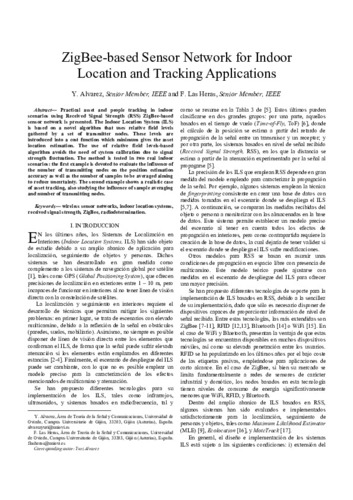ZigBee-based Sensor Network for Indoor Location and Tracking Applications
Subject:
Internet of Things
ZigBee
Redes de sensores
Localización
Radiodeterminación
Tracking
Publication date:
Editorial:
IEEE
Publisher version:
Citación:
Descripción física:
Abstract:
Practical asset and people tracking in indoor scenarios using Received Signal Strength (RSS) ZigBee-based sensor network is presented. The Indoor Location System (ILS) is based on a novel algorithm that uses relative field levels gathered by a set of transmitter nodes. These levels are introduced into a cost function which minimum gives the asset location estimation. The use of relative field levels-based algorithm avoids the need of system calibration due to signal strength fluctuation. The method is tested in two real indoor scenarios: the first example is devoted to evaluate the influence of the number of transmitting nodes on the position estimation accuracy as well as the number of samples to be averaged aiming to reduce uncertainty. The second example shows a realistic case of asset tracking, also studying the influence of sample averaging and number of transmitting nodes
Practical asset and people tracking in indoor scenarios using Received Signal Strength (RSS) ZigBee-based sensor network is presented. The Indoor Location System (ILS) is based on a novel algorithm that uses relative field levels gathered by a set of transmitter nodes. These levels are introduced into a cost function which minimum gives the asset location estimation. The use of relative field levels-based algorithm avoids the need of system calibration due to signal strength fluctuation. The method is tested in two real indoor scenarios: the first example is devoted to evaluate the influence of the number of transmitting nodes on the position estimation accuracy as well as the number of samples to be averaged aiming to reduce uncertainty. The second example shows a realistic case of asset tracking, also studying the influence of sample averaging and number of transmitting nodes
ISSN:
Patrocinado por:
Ministerio de Economía y Competitividad de España mediante el proyecto MIRIIEM TEC 2014-54005-P, y por el Gobierno del Principado de Asturias mediante el proyecto PCTI 2013-2017 GRUPIN14-14
Collections
Files in this item




